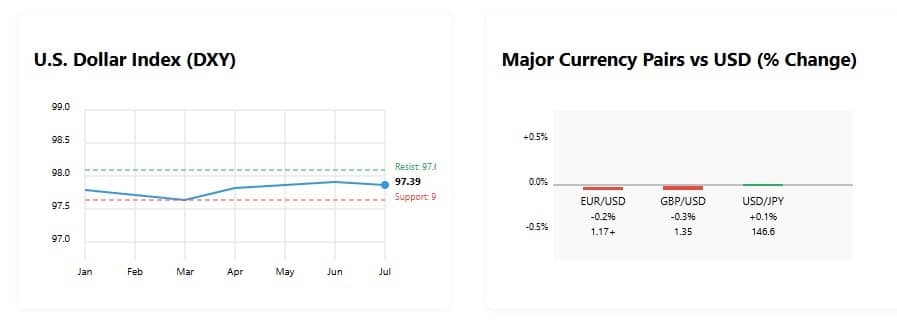The U.S. Dollar Index (DXY) is up mildly today, yet remains negative on almost all other near-term timeframes. Hovering around 97.35, cautious optimism surrounding potential trade resolutions between the United States and the European Union, balanced by ongoing concerns about global economic growth and political uncertainty in Japan has set the stage for a day of mild volatility. Looking over longer timeframes, and it is clear to see the move away from the USD as the chosen safe haven, with the DXY falling 10% YTD, as Gold has risen more than 24% in the past 6 months.
The euro, despite a slight 0.2% dip in the EUR/USD pair, remains comfortably above the 1.17 mark. This resilience underscores the euro’s strength against the dollar, fueled in part by hopes of a U.S.-EU trade detente. Cable (GBP/USD), however, has underperformed slightly, trading around 1.35, weighed down by weaker-than-expected PMI reports out of the UK. This data has raised concerns about the health of the British economy and its ability to withstand potential global headwinds. The USD/JPY pair is up a marginal 0.1% at 146.6, mirroring the overall lack of decisive movement in the currency markets.
The primary driver of market sentiment today is the ongoing negotiations between the U.S. and the EU regarding trade tariffs. Reports suggest that the two sides are nearing an agreement that would establish a 15% baseline tariff on EU imports, a significant step down from the previously threatened 30% tariffs. While this is seen as a positive development, analysts at the Financial Times point out that, when considering the initial starting point of around 5% tariffs, the proposed deal effectively locks in the existing status quo, offering limited new benefits. This nuanced interpretation has tempered some of the initial enthusiasm surrounding the trade talks.
Reports indicate the U.S. and EU are nearing a deal centered around a 15% baseline tariff, potentially stabilizing market conditions. This would essentially maintain the current status quo, considering the initial starting point of approximately 5% tariffs.
European stock markets have reacted positively to the news of potential trade agreements, with the STOXX 600 index climbing to its highest level since June 11. Major indices such as Germany’s DAX and the UK’s FTSE 100 have also experienced gains, driven by optimism surrounding the U.S.-EU trade deal and positive earnings reports from major European banks. However, the currency markets have been more restrained, suggesting that investors are taking a cautious approach and awaiting further confirmation of a concrete agreement.
Looking ahead, the DXY’s near-term trajectory will likely depend on the outcome of the U.S.-EU trade talks and the release of key economic data from both regions. Any signs of a breakdown in negotiations could trigger a flight to safety, boosting the dollar. Conversely, a confirmed trade agreement could weigh on the dollar as investors shift their focus to riskier assets. From a technical perspective, the DXY faces immediate resistance around 97.60, with a more significant hurdle at 98.00. Support lies at 97.00, a level that has acted as a psychological and recent price floor. A break below this level could open the door for further declines.
Analysts remain divided on the long-term outlook for the dollar. Some believe that the U.S. economy is poised for a rebound, which would support the dollar. Others argue that the dollar is overvalued and that its decline is inevitable, given the ongoing trade tensions and global economic uncertainty.

 Between 74-89% of CFD traders lose
Between 74-89% of CFD traders lose  Your capital is at risk
Your capital is at risk  Your capital is at risk
Your capital is at risk  Your capital is at risk
Your capital is at risk